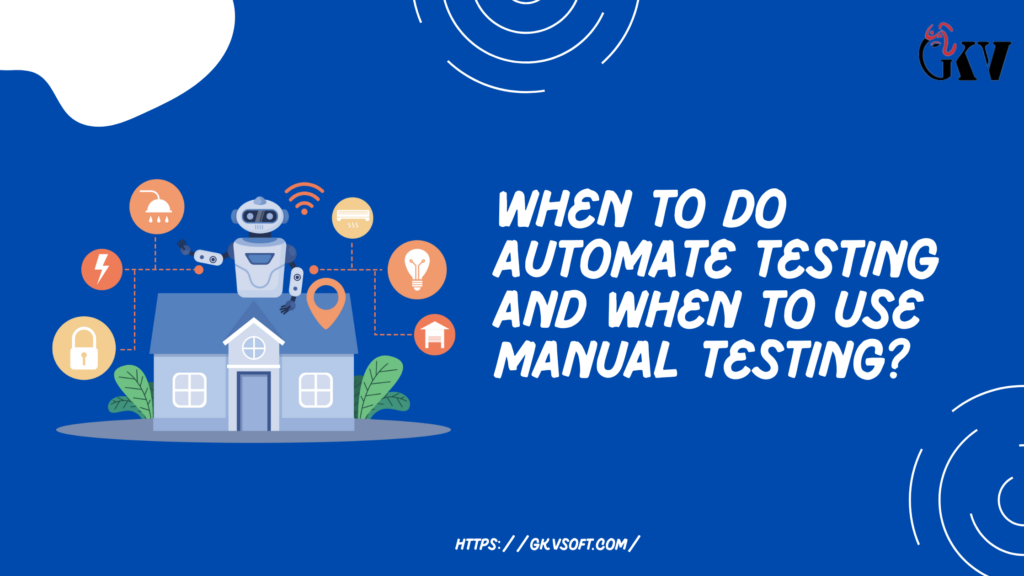As software and applications continue to evolve and improve, the quality assurance strategies used by software development companies need to keep up pace as well. That is why depending upon the situation, organizations are faced with a choice of either automation testing or manual testing. The decision may depend on understanding how test case execution fits into the project requirements, deadlines, and overall goals.
Automation Testing allows software built specifically for that purpose to write and run these types of test cases, increasing their efficiency and decreasing the amount of required human effort. It is very beneficial in situations where a specific set of test cases are executed several times for example during regression, load or performance tests.
On the other hand, manual testing software is the opposite as it requires human resources to evaluate user experience or find edge cases and issues that automated tests can’t find. A human factor is very important in these instances as users are irrational creatures.
When to Automate Test Cases in Automation Testing?
A. Automated testing is preferred for Test Cases That Are Repeated
Use automated testing when there are Repetitive test scenarios. There are build and release scenarios where mass testing is required, and it is better to automate them. Examples are login functionality tests which happen weekly at different release schedules.
B. Data-Driven Testing Requirements
Have you ever thought about how many different ways an Apple product can be purchased, and how critical it is to validate the price engine? Testing scenarios like this, with thousands of similar objects and data combinations, would be very time-consuming if manually done. Automated regression testing makes such complex cases easier, making sure large volumes of data are efficiently cross-validated without a hassle.
C. Testing of Cross-Browser and Cross-Platform
So what if you need to ensure that your web application works seamlessly on multiple browsers (Chrome, Firefox, Safari, Edge) and multiple devices( Windows, macOS, iOS, Android)? Quite a bit of time and resources can be saved by performing bulk computations on different web interfaces with the use of automated tools. This is where automation can be of great help by providing full end-to-end coverage of the test scenarios.
D. Regression Testing
As applications become more elaborate, regression testing is required. Because testing suites of regression can confirm that changes in the code do not impact previously tested functionality, they are vital for the sustenance of quality in software at larger scales.
When To Avoid Automated Testing and Stick with Manual Testing?
A. New Test Scenarios – Exploratory Testing
Exploratory testing is the perfect answer to the question When to choose manual testing? because it’s the preferred approach when there is the need for human intuition and creativity. Some areas that manual testers can work on include, but are not limited to the following:
- Try to create scenarios for which there are no automated scripts in existence.
- Think user experience for metrics that are hard to implement.
- Try to find scenarios that are words in common usage but did not exist in the testers’ minds.
B. New User Interface Testing
When your application’s UI is constantly getting updates or it is still in development, it becomes so ineffective for maintenance as well as prior compensation of automated tests takes a lot of time and energy when compared to its manual counterpart. So, when there is a rapid iteration of the interface, interface testing can be a more effective tool.
C. Manual Testing is Preferred for Standalone Tasks or Short-Term Projects
In the case of a short-term software project or a prototype that does not require repeated testing over and over again, employing a manual testing approach could offer better results. It probably would not be ideal to spend the time setting up automated tests for just one stand-up or a release.
D. Difficult to Automate Scenarios that Require Complex Interaction with User
In certain cases where classical interfaces such as multi-touch gestures or using AR/VR-dependent applications are so tightly linked; it may not be lightproof to effectively automate them. Conversely, with manual testing, there is a need to conduct detailed testing of such scenarios.
Hybrid Approach in Software Testing in 2025: 5 Steps for QA Tester:
Most Effective Testing Strategies 2025 have had a hybrid model as the starting point for their initial features testing strategies as manual testing when done gets:
Step 1: Consider the Current Procedures for Testing
Take a closer look at the testing framework of your organization and take notes of the steps that are redundant and tedious so that they can be automated and also the ones regarding which human input such as usability testing is required. Use the notes to look back and check after adjustments have been made.
Step 2: Locate the Appropriate Tools
There are several tools in the market, choose the ones most appropriate to your requirements: For automation use Selenium, Cypress, or Playwright. For manual execution use TestRail or Zephyr. Also, consider Katalon Studio because it’s a hybrid tool that enables you to do all the steps within a single interface.
Step 3: Make a Precise And Clear Test Plan
You need to first identify which parts are suitable for automation and which will not be suitable, and based on that make a decision on which parts are suitable for regression and performance testing and which are suitable for UI testing and exploratory testing specifically. However, you must remain adaptable as developments progress.
Step 4: Train the Team
You need to arrange training sessions for the team so that everyone is on the same page and has familiarity with the tools you’ve settled upon. The training should also include ways in which both developers and testers can work together to achieve better results.
Step 5: Monitor and Optimize
Keep an eye on crucial indicators such as time taken for testing and defect counts. Aim for frequent assessments and fine-tuning of the instruments, methods and workflows for better results.
Software Testing Tools and Technologies to Consider.
However, this must be done as per the requirements of the project set under the tools that are generally popularized as:
Automated Testing Tools in Software Testing
- Selenium WebDriver for testing purposes on websites
- Postman for API testing.
- Appium used for mobile test automation
- Desktop or web app testing Using TestComplete
- Cross-browser testing with the usage of playwright
Manual Testing Tools
- JIRA Defect and Test Management Software
- Confluence for Document Management
- Screen capture programs
- Bug/defect tracking tools.
GKV Soft: Software Issue Tracking Expert
GKV Soft is a Software testing service provider that offers free bug reporting services and nurses the quality of your software and applications through automated or manual testing.
In the view of GKV Soft expertise, the advice emphasizes that the trick is to get automation and manual testing in the right proportions.
Repetitive and stable tests tend to be filled with automation, whereas manual testing is filled with a human perspective that cannot be substituted. Look at each test case separately and make the appropriate selection depending on the goals and limitations of the project.
Remember: The goal is not to automate everything but to enhance your testing strategy to be more efficient and effective.
Why Choose GKV Soft for a Balanced Testing Approach?
1. Hybrid Testing Skills
GKV Soft specializes in combining automated and manual testing and going towards the right direction where speed is key without losing quality.
2. Reliable Testing Cost
By automating testing, GKV reduces the total cost of software testing while maintaining a level of coverage and quality that’s high. You reduce the amount of time and resources.
3. Highly Trained QA Testers
GKV Soft was able to recruit a team who are functional, performance and usability testing experts and also a fully experienced team in Selenium Appium, JIRA, certification and industry knowledge.
4 Successful Track Record
With years of experience, GKV Soft covers different industries such as Finance and Banking, Healthcare, E-commerce and retail industries, GKV Soft with deep insight into other sector challenges understands the importance of strong partnerships, and repeat client relationships.
Conclusion:
The innovative testing strategy of GKV Soft incorporates both manual and automated tests and is effective in delivering high-quality software. The use of the guiding principles and guidelines described above makes it possible for our resource teams to deliver high-quality software solutions and at the same time, optimal resource usage is maintained.

